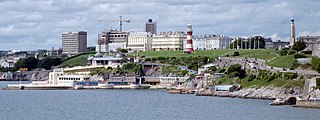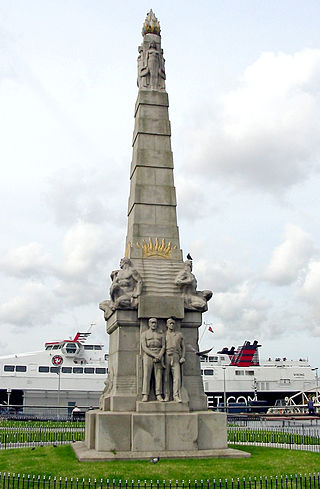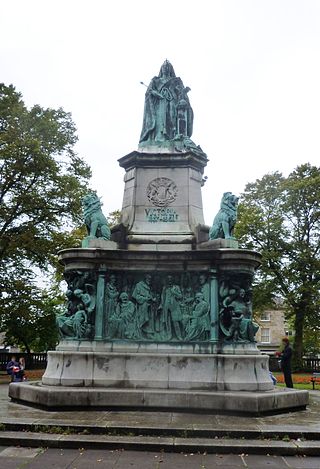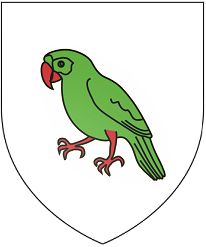
Plymouth Hoe, referred to locally as the Hoe, is a large south-facing open public space in the English coastal city of Plymouth. The Hoe is adjacent to and above the low limestone cliffs that form the seafront and it commands views of Plymouth Sound, Drake's Island, and across the Hamoaze to Mount Edgcumbe in Cornwall. The name derives from the Anglo-Saxon word hoh, a sloping ridge shaped like an inverted foot and heel.

Nelson's Column is a monument in Trafalgar Square in the City of Westminster, Central London, built to commemorate Vice-Admiral Horatio Nelson's decisive victory at the Battle of Trafalgar over the combined French and Spanish navies, during which he lost his life. The monument was constructed between 1840 and 1843 to a design by William Railton at a cost of £47,000. It is a column of the Corinthian order built from Dartmoor granite. The statue of Nelson was carved from Craigleith sandstone by sculptor Edward Hodges Baily. The four bronze lions around its base, designed by Sir Edwin Landseer, were added in 1867.

Tavistock is an ancient stannary and market town within West Devon, England. It is situated on the River Tavy from which its name derives. At the 2011 census the three electoral wards had a population of 13,028. It traces its recorded history back to at least 961 when Tavistock Abbey, whose ruins lie in the centre of the town, was founded. Its most famous son is Sir Francis Drake.

The Royal Citadel in Plymouth, Devon, England, was built in the late 1660s to the design of Sir Bernard de Gomme. It is at the eastern end of Plymouth Hoe overlooking Plymouth Sound, and encompasses the site of the earlier fort that had been built in the time of Sir Francis Drake. The citadel site is a Scheduled Monument and many of the buildings within are Grade II Listed.

Wellington's Column, or the Waterloo Memorial, is a monument to the Duke of Wellington standing on the corner of William Brown Street and Lime Street, Liverpool, Merseyside, England. It is recorded in the National Heritage List for England as a designated Grade II* listed building.

Coade stone or Lithodipyra or Lithodipra is stoneware that was often described as an artificial stone in the late 18th and early 19th centuries. It was used for moulding neoclassical statues, architectural decorations and garden ornaments of the highest quality that remain virtually weatherproof today.

The History of Plymouth in Devon, England, extends back to the Bronze Age, when the first settlement began at Mount Batten a peninsula in Plymouth Sound facing onto the English Channel. It continued as both a fishing and continental tin trading port through the late Iron Age into the Early Medieval period, until the more prosperous Saxon settlement of Sutton, later renamed Plymouth, surpassed it. With its natural harbour and open access to the Atlantic, the town found wealth and a national strategic importance during the establishment of British naval dominance in the colonisation of the New World. In 1620 the Pilgrim Fathers departed from Plymouth to establish the second English colony in America. During the English Civil War the town was besieged between 1642 and 1646 by the Royalists, but after the Restoration a Dockyard was established in the nearby town of Devonport. Throughout the Industrial Revolution Plymouth grew as a major mercantile shipping industry, including imports and passengers from the US, whilst Devonport grew as a naval base and ship construction town, building battleships for the Royal Navy – which later led to its partial destruction during World War II in a series of air-raids known as the Plymouth Blitz. After the war was over, the city centre was completely rebuilt to a new plan.

The Memorial to Heroes of the Marine Engine Room is a granite monument located on St. Nicholas Place, at the Pier Head, in Liverpool, England.
The following is a timeline of the history of the city of Plymouth, Devon, England.

The Port Sunlight War Memorial stands in a central position in the model village of Port Sunlight, Wirral, Merseyside, England. The founder of the village and employer of its residents, William Lever, was anxious to have a memorial to commemorate those of his workers who had been lost in the First World War. As early as 1916 he commissioned Goscombe John to design a war memorial, which was completed and unveiled in 1921 by two of his employees. It consists of a granite runic cross with bronze statues and reliefs and has the theme "Defence of the Realm". On the memorial are the names of all of the company's employees who died as a result of both World Wars. It is recorded in the National Heritage List for England as a designated Grade I listed building.

An equestrian statue of Arthur Wellesley, 1st Duke of Wellington, stands on the north side of Hyde Park Corner, London. The open space in which it stands, now the centre of a large roundabout, was once called Wellington Place.

The Queen Victoria Memorial in Lancaster, Lancashire, England, is a Grade II* listed building. It stands in the centre of Dalton Square, Lancaster facing Lancaster Town Hall. It was erected in 1906, being commissioned and paid for by James Williamson, 1st Baron Ashton.

Thomas Parlby (1727–1802) Stone Hall, Stonehouse, in Plymouth "the big house overlooking Stonehouse Pool", was a civil engineering contractor described in his obituary in the Gentleman's Magazine as "Master Mason of HM Docks".

The statue of Charles James Fox stands at the north end of Bloomsbury Square in the London borough of Camden. Erected in 1816, the sculptor was Richard Westmacott. It commemorates the Whig politician who died in 1806. Fox is shown in the garb of a Roman senator. The statue is a Grade II* listed structure.

A bronze statue of General Charles George Gordon by Hamo Thornycroft stands on a stone plinth in the Victoria Embankment Gardens in London. It has been Grade II listed since 1970. A similar statue stands at Gordon Reserve, near Parliament House in Melbourne, Australia, on its original tall plinth.

The Memorial to Arthur Sullivan by William Goscombe John stands in Victoria Embankment Gardens in the centre of London. It was designated a Grade II listed structure in 1958.

Erected in 1923, the Thornton-Cleveleys War Memorial is located in the English conurbation of Thornton-Cleveleys, Lancashire. A Grade II listed structure, it stands in a small garden in the southwestern corner of a junction known as Four Lane Ends.

The Gladstone Memorial on the Strand, London is a bronze sculpture of the British statesman, created by Hamo Thornycroft between 1899-1905. The statue was erected as the national memorial to Gladstone and shows him in the robes of the Chancellor of the Exchequer. The figure stands on a plinth surrounded by allegorical figures depicting four of the Virtues, Courage, Brotherhood, Education and Aspiration. The memorial is a Grade II listed structure.




















